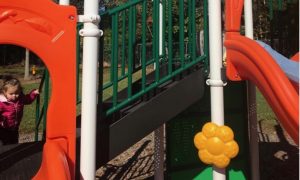It is often said that math is all around us. Playgrounds, for instance, can be a great place for caregivers and children to explore the math around them as they play. Let’s see what that means for a young child and a caregiver. (Words that highlight everyday math concepts are in italics.)
Notice Math Around You
2-year-old Cassie (pictured) is at her local playground. Math is all around her, whether she notices it or not. Some of this math would be easy for her; some would be hard and best saved for when she is older; and some will have just the right amount of challenge to be fun and promote learning.

For example, as Cassie is climbing steps on her way to the top of the play structure, the steps can be counted. There are about three steps to start, and then about four or five to get to the next level. This is a lot of steps to climb (especially for a young child!). The steps provide many opportunities for you to promote number learning by talking about counting and quantity (e.g., lots, more, and fewer) as she climbs.
At the start, Cassie climbs to the top, going up and up and up. Later, Cassie climbs to the bottom, going down and down and down.This is all about direction, which is an important part of spatial relations, a key early math topic.
When Cassie begins to climb again, she is at the bottom; when she reaches the top, she is up high, higher than she was at the beginning. This is all about understanding height and differences in height—again, a part of spatial relations.
Also, notice in the picture above the white pole with the orange object that resembles a sunflower. It has a big circle in the middle, surrounded by six incomplete circles (partially cut-off circles). Within each of those six are seven smaller circles. The smaller circles and larger incomplete circles are shapes. Their arrangement—circle in the middle, incomplete circles surrounding it, and smaller circles within the incomplete circles—is also all about spatial relations.
Talk About Math in Everyday Life
So, math is all around us in the sense that it’s there to be seen if you look for it. This everyday math is very different from the formal math you learned in school. But young children love to engage in and learn about everyday math, and it can serve as the foundation for their later learning and success in school.
How can you use the math that is all around us to support your child’s math development? Help your child to see basic math in the everyday world, for example at the playground. The best way to do this is by using language to point out and explore the math in their world.
Here are some examples of what you can say to a young children at the playground:
- “Let’s count the steps: One, two, three. There are three steps. Look, now there are more steps.”
- “Here’s one more step, and one more again. Almost at the top—two more steps.”
- “We are going up, up, and up. Look down. We’re up high now.”
- “Now we’re going to go down. Take one step down. Now another step.”
- “Now look back. Look how far down we’ve come. We’re almost at the bottom. Only two more steps left.”
- “Look at the big orange circle over there on the white pole. Look at all these little circles. There are so many of them. Let’s count them.”
Keep the Conversation Going
After making comments on the math, try to keep the conversation going. The child may make a reply that you will then want to respond to. For example, if you say, “Look, now there are more steps,” your child may say, “Lots of steps!” And then you can say, “Yes, lots of steps. Let’s count them.”
What’s the right number of comments to make? Saying all the examples above would be overwhelming. Say only as much as you feel comfortable saying and what you think your child will understand.
Keep in mind that everyday math conversations are not lessons. Math talk is meant to be a conversation about features of the world that your child will find interesting. Let children enjoy the playground. That, after all, is the primary goal!